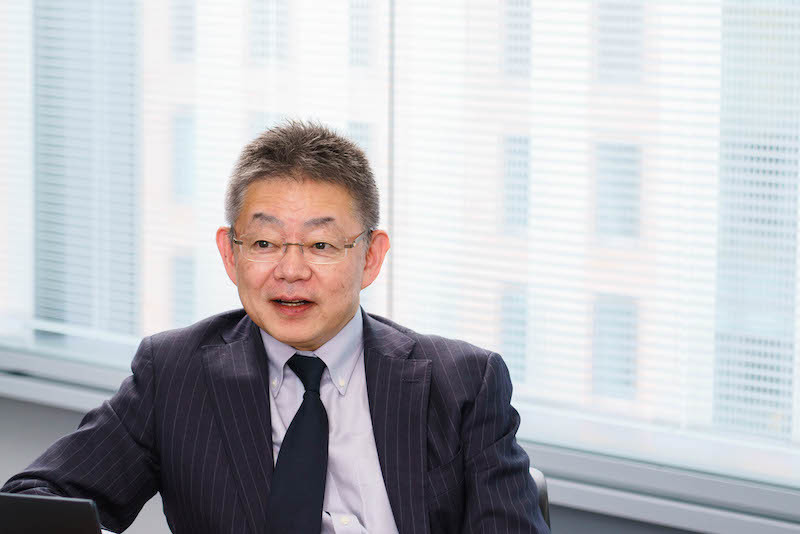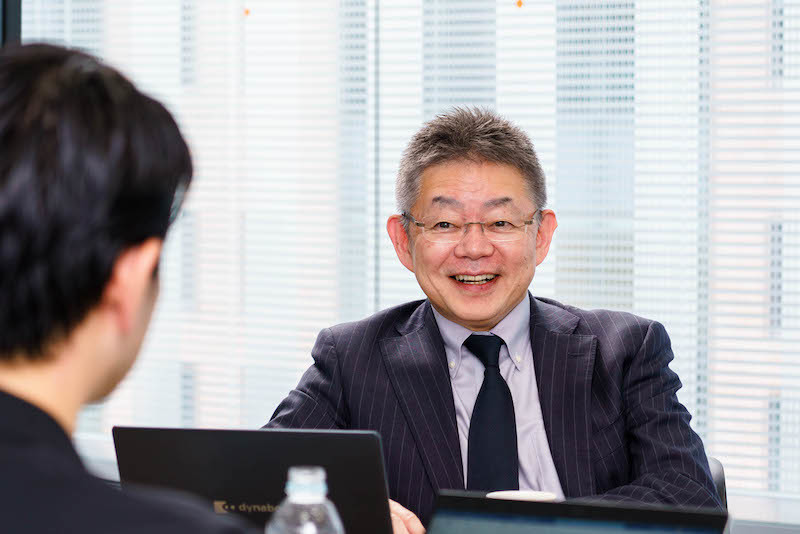This series features conversations between startup entrepreneurs, executives, investors, CMOs, and others with Dentsu Inc. employees who support startups, exploring how they overcame challenges during their company or business growth.
This installment features Mr. Mitsuru Sugawara, President and CEO of QD Laser, Inc. The company's mission is "Transforming 'Impossible' into 'Possible' with the Power of Lasers." It develops new semiconductor laser solutions for fields like communications, industry, and healthcare, and runs the "With My Eyes" project, which expands possibilities for people with low vision using retinal projection laser technology.
Dentsu Inc.'s Hiroki Ochi and Takato Akiyama delved into the company's growth story: over a decade of R&D through multiple funding rounds, achieving the world's first mass production of quantum dot lasers, securing medical device manufacturing certification to enter healthcare, and finally going public in February 2021.

(From left) Dentsu Inc.'s Ochi, QD Laser's Sugawara, Dentsu Inc.'s Akiyama
We couldn't let this groundbreaking technology remain unimplemented in society.
Ochi: We've had a deep partnership with QD Laser since around summer 2019, even before their 2021 IPO . Hearing the detailed journey to their listing, including episodes from their founding days, fundraising multiple times, and expanding their business, I feel they've overcome various hurdles to reach this point.
This time, I'd like to ask about how you navigated those difficulties and major crossroads. Specifically, "What growth story did you paint, and how did you engage many stakeholders to move things forward?" To start, could you briefly explain to our readers what kind of company QD Laser is?
Sugawara: Originally, I was conducting R&D on semiconductor lasers at Fujitsu Laboratories. However, around 2000, the department tasked with commercializing semiconductor lasers was sold off due to the impact of the telecom bubble burst. After that, we continued researching quantum dot lasers as a national project with support from the Ministry of Economy, Trade and Industry (METI) and the Ministry of Education, Culture, Sports, Science and Technology (MEXT). This project also concluded in 2005.
Quantum dots are semiconductor microcrystals measuring from a few nanometers to tens of nanometers. Quantum dot lasers using these achieve high temperature stability and low power consumption. We couldn't let this groundbreaking technological development end without being implemented in society. Driven by this conviction, our company was launched in 2006 as a spin-off venture from Fujitsu Laboratories, aiming to commercialize quantum dot laser technology. The founding team consisted of four members, and the company name "QD Laser" originates from "Quantum dot."
To date, we have successfully developed and mass-produced the world's first current-free quantum dot laser for communications. We have also developed the "pico-short pulse DFB laser" enabling non-thermal processing and high-definition machining in precision manufacturing, the "compact visible laser" applicable to biomedical flow cytometers and microscopes, We also developed a "quantum dot laser array" for silicon photonic circuits and the "RETISSA" series of retinal scanning laser eyewear. In February 2021, we listed on the Tokyo Stock Exchange Mothers market.

QD Laser, Mr. Sugawara
Ochi: At that time, quantum dot lasers were still in the R&D phase and hadn't been commercialized yet. How did you gather investors and initial members under those circumstances?
Sugawara: First, I wrote a business plan and consulted Professor Yasuhiko Arakawa of the University of Tokyo, who was leading a national project. He introduced me to someone at Mitsui & Co., who was focused on industry-academia collaboration. Coincidentally, that person had connections to Fujitsu's venture capital team. Thanks to that connection, we were able to launch with joint investment from Fujitsu and Mitsui & Co.
We steadily sought members from academic networks. It was a period of decline in the electronics industry, with many early retirements from major manufacturers, so we were also able to recruit experienced, talented individuals through that route. Everyone joined because they were passionate about the challenge of bringing groundbreaking technology to society. However, I believe the backing from Fujitsu and the foundation of national basic research were also significant factors.

Dentsu Inc., Mr. Ochi
Continuously communicating the social significance of laser eyewear, achieving over ¥9 billion in total funding
Ochi: Subsequently, in 2008, we achieved the world's first quantum dot laser for optical communications operating between -40°C and 100°C. While continuing to secure funding, we succeeded in the world's first practical mass production of a 10Gbps quantum dot laser for optical communications in 2009.
Why did you expand into multiple fields like material processing and sensing, rather than proceeding directly with commercialization in the communications domain?
Sugawara: The communications field presented insurmountable standards barriers, making immediate market entry difficult. While we possessed core technology no one could replicate and had talented personnel, we lacked a business to sustain QD Laser. To broaden our business potential, we expanded into processing, sensing, and displays.
Akiyama: How did you explain to investors that entering the communications market—which you'd long targeted—was proving difficult? Depending on how you framed it, that could have been taken quite harshly.

Dentsu Inc. Mr. Akiyama
Sugawara: We explained that our business model involves creating materials using our core technology, then selling products manufactured externally via a fabless approach (a business model without in-house manufacturing facilities). We emphasized that opportunities existed in any field where our core technology could be applied. Later, when we asked investors, it seems they had thought, "QD Laser might not make it" (laughs).
At the time, we were already generating annual sales of around 100 million yen, so the business wasn't completely unviable. Still, I think additional investment required considerable courage on the investors' part.
Ochi: Furthermore, the display business—specifically the laser eyewear venture—took an even bolder step by challenging the medical field. Ultimately, after investing over 4 billion yen over about five years, it finally entered the recovery phase. How did you manage fundraising during this period?
Sugawara: We explained not only the business perspective—that we had core technology and intellectual property, and that obtaining medical certification would create highly unique value—but also the significant social impact. We emphasized the potential to help people with low vision see the world they couldn't before and extend the healthy lifespan of their eyes.
Akiyama: How did investors react at that time?
Sugawara: That varied from person to person. We met with countless individuals, repeatedly explaining the project's profound social significance. Those who resonated with our vision ultimately invested.
Ochi: On the other hand, I'm also curious about how you explained things to your employees. Even though they understood that commercialization takes time and money, I imagine they inevitably felt some anxiety or uncertainty. How did you manage that?
Sugawara: We made sure to explain the fundraising status and cash flow breakdown as transparently as possible. We'd say, "Right now, we have this much in losses, but here's how the cash flow is moving, and we have this funding coming in, so it's okay."
Ochi: I see. So you made sure to proceed while properly ensuring psychological safety.
People won't put money into something they can't visualize the value of
Akiyama: Through ongoing communication with internal and external stakeholders, including investors, you've experienced both successes and failures. What insights or mindset shifts emerged from that?
Sugawara: In the past, researchers and engineers could just create something new and publish it in a paper. But now, that alone isn't enough. You have to communicate how what you've created will be implemented in society and what kind of value or change it will generate. People won't put money into something they can't concretely visualize, nor will they want to cooperate. Personally, I've had a win rate of about 1 in 10, repeatedly explaining things and continuously refining how I communicate. Only recently have I started to feel that more people are understanding.
Akiyama: I imagine it's easier for people to visualize if there's some track record to show. But when explaining things at the earlier R&D stage, is there anything you consciously focus on?
Sugawara: Since you're essentially pitching a crazy idea to them, it's crucial to imagine who they are, what they're thinking, and what information they have, then tailor your explanation accordingly. Even if the core story remains the same, I adjust the order and content for each individual.
Akiyama: I see. So you have a core story, but you customize it based on who you're talking to.
Sugawara: Exactly. I believe the key is answering the question, "What value does this hold for me?"
(Continued in Part 2)













